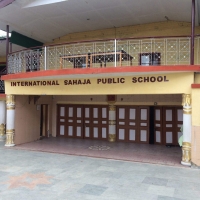International Sahaja Public School in Dharamsala, Himachal Pradesh Admission, Fees Structure

Where is International Sahaja Public School ?
International Sahaja Public School is Located in Dharamsala , Himachal Pradesh, India
Address of International Sahaja Public School, Dharamsala
Naddi, Talnoo, Dharamshala Cantt.
Dharamshala, Dist. – Kangra
Himachal Pradesh – 176216
India
How do I contact International Sahaja Public School?
Call at +91 -189 222 0916 to contact International Sahaja Public School
About International Sahaja Public School
The School prepares students for the Class 10 and Class 12 Indian Certificate of Secondary Education [ICSE/ISC]. The ICSE examination is administered by the Council for the Indian School Certificate Examinations: a board set up in India in 1956 to administer examinations equivalent to University of Cambridge Local Syndicate Examinations. The Class 10 ICSE Board Examination is a public board examination for students in India at the end of Class 10 and Class 12 (equivalent to GCSE or the four years of High School program.) Seven subjects are taken, of which four are compulsory and three are chosen from different groups of subjects. A syllabus from the board is available for anyone wishing to see it. Similarly Class 12, ISC board examination is conducted for Class 12 which is equivalent to the final year of the GCSE High School Program. The School has at present a general library with around 3000 books. With the completion of the new academic block this will be developed further. Books are available to the students according to the age levels. There is also an extensive library of Sahaja books and Shri Mataji’s audio and video cassettes. We have a video-cassette / CD / DVD library of academic aids, documentaries and general films considered suitable for young minds. There is a recreation hall where celebrations are held and students watch films.
On 19 January 2017, Chief Minister Virbhadra Singh declared Dharamshala as the second capital of Himachal Pradesh state, making Himachal Pradesh the third state of India with two capitals after Jammu and Kashmir and Maharashtra
The predominantly mountainous region comprising the present-day Himachal Pradesh has been inhabited since pre-historic times having witnessed multiple waves of human migration from other areas Through its history, the region was mostly ruled by local kingdoms some of which accepted the suzerainty of larger empires Prior to India's independence from the British, Himachal comprised the hilly regions of Punjab Province of British India After independence, many of the hilly territories were organized as the Chief Commissioner's province of Himachal Pradesh which later became a union territory In 1966, hilly areas of neighboring Punjab state were merged into Himachal and it was ultimately granted full statehood in 1971.
Himachal Pradesh is spread across valleys with many perennial rivers flowing through them Almost 90% of the state's population lives in rural areas Agriculture, horticulture, hydropower and tourism are important constituents of the state's economy The hilly state is almost universally electrified with 995% of the households having electricity as of 2016.
The state was declared India's second open-defecation-free state in 2016 According to a survey of CMS – India Corruption Study 2017, Himachal Pradesh is India's least corrupt state